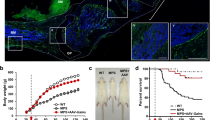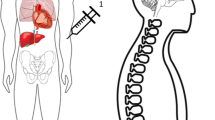Abstract
Mucopolysaccharidosis type I (MPSI) is an autosomic recessive, lysosomal storage disorder due to the deficit of the enzyme α-L-iduronidase (IDUA). The disease accounts for a general impairment of tissue and organ functions, mainly including heart disease, corneal clouding, organomegaly, skeletal malformations and joint stiffness. Neurological deterioration affects the severe forms. Both haemopoietic stem cell transplantation and enzyme replacement therapy can be applied to the treatment of the disorder; however, they both present several limitations. Thus, the search for alternative strategies to complement the present procedures is highly desirable. A murine myoblast cell line engineered to overexpress IDUA was generated and enclosed in alginate microcapsules, which were intra-peritoneally implanted in the MPSI mouse model. Plasma and tissue enzyme activity induced by the treatment and urinary and tissue glycosaminoglycan content were monitored in the animals, progressively sacrificed up to 4 months after implantation. Significant induction of enzyme activity and reduction of glycosaminoglycan accumulation were detected in the implanted animals, complete normalization of deposits was achieved in two animals. Intra-peritoneal implantation of alginate microcapsule confirms to be a valid approach as an endogenous enzyme replacement procedure.
This is a preview of subscription content, access via your institution
Access options
Subscribe to this journal
Receive 12 print issues and online access
$259.00 per year
only $21.58 per issue
Buy this article
- Purchase on Springer Link
- Instant access to full article PDF
Prices may be subject to local taxes which are calculated during checkout









Similar content being viewed by others
References
Neufeld EF, Muenzer J . The mucopolysaccharidoses. In: The Metabolic and Molecular Bases of Inherited Disease, Vol. 3. McGraw-Hill Professional Publishing: New York, 2001, pp 3421–3452.
Illsinger S, Lucke T, Hartmann H, Mengel E, Muller-Forell W, Donnerstag F et al. Scheie syndrome: enzyme replacement therapy does not prevent progression of cervical myelopathy due to spinal cord compression. J Inherit Metab Dis. Short Report #190 (2009), Published online 4 November 2009; doi:10.1007/s10545-009-1265-y.
Hobbs JR, Hugh-Jones K, Barrett AJ, Byrom N, Chambers D, Henry K et al. Reversal of clinical features of Hurler's disease and biochemical improvement after treatment by bone-marrow transplantation. Lancet 1981; 2: 709–712.
Peters C, Steward CG . Hematopoietic cell transplantation for inherited metabolic diseases: an overview of outcomes and practice guidelines. Bone Marrow Transplant 2003; 31: 229–239.
Wraith JE . Enzyme replacement therapy in mucopolysaccharidosis type I: progress and emerging difficulties. J Inherit Metab Dis 2001; 24: 245–250.
Wraith JE, Beck M, Lane R, van der Ploeg A, Shapiro E, Xue Y et al. Enzyme replacement therapy in patients who have mucopolysaccharidosis I and are younger than 5 years: results of a multinational study of recombinant human alpha-L-iduronidase (laronidase). Pediatrics 2007; 120: e37–e46.
Messina C, Rampazzo A, Cesaro S, Monciotti C, Gasparotto N, Tomanin R et al. Eighteen-year follow-up of the first Italian MPSI patient treated with bone marrow transplantation. Bone Marrow Transplant 2008; 41: 905–906.
Clarke LA . Mucopolysaccharidosis Type I. In: Pagon RA, Bird TD, Dolan CR, Stephens K (eds). GeneReviews. University of Washington, Seattle: Seattle (WA), 1993.
Platt FM, Lachmann RH . Treating lysosomal storage disorders: current practice and future prospects. Biochim Biophys Acta 2009; 1793: 737–745.
Chang PL . Microcapsules as bio-organs for somatic gene therapy. Ann NY Acad Sci 1997; 831: 461–473.
Ross CJ, Bastedo L, Maier SA, Sands MS, Chang PL . Treatment of a lysosomal storage disease, mucopolysaccharidosis VII, with microencapsulated recombinant cells. Hum Gene Ther 2000; 11: 2117–2127.
Hernandez RM, Orive G, Murua A, Pedraz JL . Microcapsules and microcarriers for in situ cell delivery. Adv Drug Deliv Rev 2010; 62: 711–730.
Barsoum SC, Milgram W, Mackay W, Coblentz C, Delaney KH, Kwiecien JM et al. Delivery of recombinant gene product to canine brain with the use of microencapsulation. J Lab Clin Med 2003; 142: 399–413.
Friso A, Tomanin R, Alba S, Gasparotto N, Puicher EP, Fusco M et al. Reduction of GAG storage in MPS II mouse model following implantation of encapsulated recombinant myoblasts. J Gene Med 2005; 7: 1482–1491.
Ohmi K, Greenberg DS, Rajavel KS, Ryazantsev S, Li HH, Neufeld EF . Activated microglia in cortex of mouse models of mucopolysaccharidoses I and IIIB. Proc Natl Acad Sci USA 2003; 100: 1902–1907.
Wen J, Vargas AG, Ofosu FA, Hortelano G . Sustained and therapeutic levels of human factor IX in hemophilia B mice implanted with microcapsules: key role of encapsulated cells. J Gene Med 2006; 8: 362–369.
Muenzer J, Fisher A . Advances in the treatment of mucopolysaccharidosis type I. N Engl J Med 2004; 350: 1932–1934.
Desnick RJ . Enzyme replacement and enhancement therapies for lysosomal diseases. J Inherit Metab Dis 2004; 27: 385–410.
Herati RS, Ma X, Tittiger M, Ohlemiller KK, Kovacs A, Ponder KP . Improved retroviral vector design results in sustained expression after adult gene therapy in mucopolysaccharidosis I mice. J Gene Med 2008; 10: 972–982.
Mercimek-Mahmutoglu S, Reilly C, Human D, Waters PJ, Stoeckler-Ipsiroglu S . Progression of organ manifestations upon enzyme replacement therapy in a patient with mucopolysaccharidosis type I/Hurler. World J Pediatr 2009; 5: 319–321.
Kakkis ED, Schuchman E, He X, Wan Q, Kania S, Wiemelt S et al. Enzyme replacement therapy in feline mucopolysaccharidosis I. Mol Genet Metab 2001; 72: 199–208.
Regulation (EC) No 1394/2007 of the European Parliament and of the Council of 13 November 2007 on advanced therapy medicinal products and amending Directive 2001/83/EC and Regulation (EC) No 726/2004 (Text with EEA relevance). OJ 2007; L324: 121–137.
Food and Drug Administration. Application of current statutory authorities to human somatic cell therapy products and gene therapy products. Fed Regist 1993; 58: 53248–53251.
de Vos P, Bucko M, Gemeiner P, Navratil M, Svitel J, Faas M et al. Multiscale requirements for bioencapsulation in medicine and biotechnology. Biomaterials 2009; 30: 2559–2570.
Montgomery DL, Shiver JW, Leander KR, Perry HC, Friedman A, Martinez D et al. Heterologous and homologous protection against influenza A by DNA vaccination: optimization of DNA vectors. DNA Cell Biol 1993; 12: 777–783.
Hortelano G, Al-Hendy A, Ofosu FA, Chang PL . Delivery of human factor IX in mice by encapsulated recombinant myoblasts: a novel approach towards allogeneic gene therapy of hemophilia B. Blood 1996; 87: 5095–5103.
Di Domenico C, Villani GR, Di Napoli D, Reyero EG, Lombardo A, Naldini L et al. Gene therapy for a mucopolysaccharidosis type I murine model with lentiviral-IDUA vector. Hum Gene Ther 2005; 16: 81–90.
Tomanin R, Friso A, Alba S, Piller Puicher E, Mennuni C, La Monica N et al. Non-viral transfer approaches for the gene therapy of mucopolysaccharidosis type II (Hunter syndrome). Acta Paediatr Suppl 2002; 91: 100–104.
Bjornsson S . Simultaneous preparation and quantitation of proteoglycans by precipitation with alcian blue. Anal Biochem 1993; 210: 282–291.
Whitley CB, Ridnour MD, Draper KA, Dutton CM, Neglia JP . Diagnostic test for mucopolysaccharidosis. I. Direct method for quantifying excessive urinary glycosaminoglycan excretion. Clin Chem 1989; 35: 374–379.
de Jong JG, Wevers RA, Liebrand-van Sambeek R . Measuring urinary glycosaminoglycans in the presence of protein: an improved screening procedure for mucopolysaccharidoses based on dimethylmethylene blue. Clin Chem 1992; 38: 803–807.
Acknowledgements
We wish to thank Elizabeth Neufeld (UCLA, CA, USA) and JM Heard (Pasteur Institute, Paris, France) for kindly providing the mouse model, E Kakkis (BioMarin, CA, USA) for anti-IDUA mouse serum, Jianping Wen (McMaster University, Hamilton, Ontario, Canada) for encapsulating C2C12-IDUA engineered cells. The project was funded by the Italian Ministry of Health (PRIN 2006, Grant no. 2006064337_002) and by the Italian Mucopolysaccharidosis Association (AIMPS). We also acknowledge funding from Canadian Blood Services to GH.
Author information
Authors and Affiliations
Corresponding author
Ethics declarations
Competing interests
The authors declare no conflict of interest.
Rights and permissions
About this article
Cite this article
Piller Puicher, E., Tomanin, R., Salvalaio, M. et al. Encapsulated engineered myoblasts can cure Hurler syndrome: preclinical experiments in the mouse model. Gene Ther 19, 355–364 (2012). https://doi.org/10.1038/gt.2011.94
Received:
Revised:
Accepted:
Published:
Issue Date:
DOI: https://doi.org/10.1038/gt.2011.94
Keywords
This article is cited by
-
Subcutaneous implantation of microencapsulated cells overexpressing α-L-iduronidase for mucopolysaccharidosis type I treatment
Journal of Materials Science: Materials in Medicine (2017)
-
A Perspective on Bioactive Cell Microencapsulation
BioDrugs (2012)



